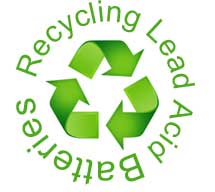Recycling Batteries

Lead is always among one of the most recycled materials in terms of recovery rate. It can be remelted infinitely to remove impurities. Its fundamental properties make it easily identifiable and cost-effective to collect and recycle. More than 50 percent of lead used in the production of new lead products around the world is sourced from recycled lead. All lead produced in the U.S. and 74 percent of lead produced in Europe comes from recycled stock. The current lead recycling rate in North America and Europe is nearly 100 percent. As the quality of the recycled lead is almost identical to primary lead collected directly from mining, its value and demand as a recycled material are very high.
At the smelter, collected batteries are broken and scrap lead is safely separated from other components. Then, lead components are systematically smelted and refined.The battery is broken apart in a hammer mill, a machine that breaks the battery into pieces. The broken battery pieces go into a vat, where the lead and heavy materials fall to the bottom while the plastic rises to the top. At this point, the polypropylene pieces are scooped away and the liquids are drawn off, leaving the lead and heavy metals. Each of the materials then begins its own recycling journey. We'll begin with the plastic, or polypropylene.
The polypropylene pieces are washed, blown dry and sent to a plastic recycler where the pieces are melted together into an almost-liquid state. The molten plastic is put through an extruder that produces small plastic pellets of a uniform size. Those pellets are sold to the manufacturer of battery cases, and the process begins again.
The lead grids, lead oxide and other lead parts are cleaned and then melted together in smelting furnaces. The molten lead is poured into ingot molds. Large ingots, weighing about 2,000 pounds are called hogs. Smaller ingots, weighing 65 pounds, are called pigs. After a few minutes, the impurities, otherwise known as dross, float to the top of the still-molten lead in the ingot molds. The dross is scraped away, and the ingots are left to cool.
When the ingots are cool, they are removed from the molds and sent to battery manufacturers, where they are re-melted and used in the production of new lead plates and other parts for new batteries.

